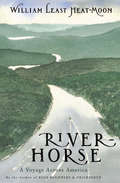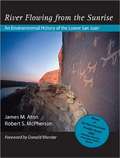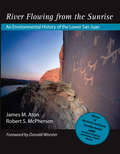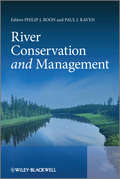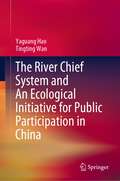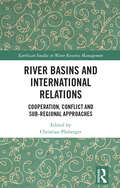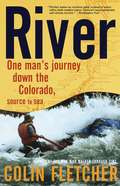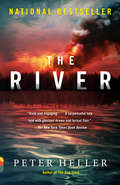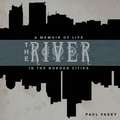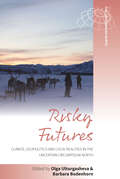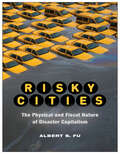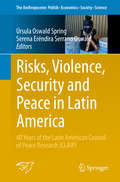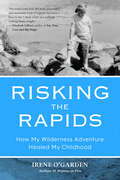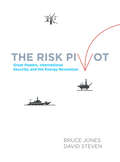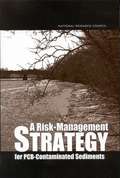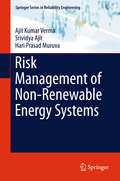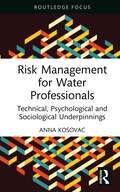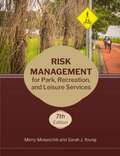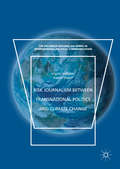- Table View
- List View
The River Horse
by Nina Ames FreyEvery child wants a horse, and Arana, a young Mayan Indian boy living in a Guatemalan village, is no exception. From his grandfather he hears tales of his people's past greatness. He hears, too, stories of how the Spanish soldiers came, mounted on their horses, and conquered his ancestors, who had never seen horses and were afraid. One day in the forest with his father he sees a danta, a little wild animal native to Guatemala that is known as a river horse. Arana returns to the forest on his own to try to capture the little danta and have the rare river horse for his own.
River-Horse: A Voyage Across America (Core Ser.)
by William Least Heat-MoonNew York Times bestseller: &“A coast-to-coast journey by way of great rivers, conducted by a contemporary master of travel writing&” (Kirkus Reviews). In this memoir brimming with history, humor, and wisdom, the author of Blue Highways and PrairyErth &“voyages across the country, from Atlantic to Pacific, almost entirely by its rivers, lakes and canals in a small outboard-powered boat&” (San Francisco Chronicle). Setting off from New York Harbor aboard the boat he named Nikawa (&“river horse&” in Osage), in hopes of entering the Pacific near Astoria, Oregon, William Least Heat-Moon and his companion, Pilotis, struggle to cover some five thousand watery miles—more than any other cross-country river traveler has ever managed—often following in the wakes of our most famous explorers, from Henry Hudson to Lewis and Clark. En route, the voyagers confront massive floods, submerged rocks, dangerous weather, and their own doubts about whether they can complete the trip. But the hard days yield incomparable pleasures: strangers generous with help and eccentric tales, landscapes unchanged since Sacagawea saw them, riverscapes flowing with a lively past, and the growing belief that efforts to protect our lands and waters are beginning to pay off. &“Fizzes with intelligence and high spirits.&” —Outside &“Propels the reader with historical vignettes, ecological and geological detail, and often hilarious encounters with local eccentrics.&” —Time
River Flowing from the Sunrise
by James M. Aton Robert S. McphersonThe authors recount twelve millennia of history along the lower San Juan River, much of it the story of mostly unsuccessful human attempts to make a living from the river's arid and fickle environment. From the Anasazi to government dam builders, from Navajo to Mormon herders and farmers, from scientific explorers to busted miners, the San Juan has attracted more attention and fuelled more hopes than such a remote, unpromising, and muddy stream would seem to merit.
River Flowing From The Sunrise: An Environmental History of the Lower San Juan
by James M Aton Robert McPhersonThe authors recount twelve millennia of history along the lower San Juan River, much of it the story of mostly unsuccessful human attempts to make a living from the river's arid and fickle environment. From the Anasazi to government dam builders, from Navajo to Mormon herders and farmers, from scientific explorers to busted miners, the San Juan has attracted more attention and fueled more hopes than such a remote, unpromising, and muddy stream would seem to merit.
River Conservation and Management
by Paul Raven Philip BoonThis book is intended for those with an academic, scientific and practical interest in river conservation and management. It provides an overview of how changes in legislation, policies, institutional responsibilities, science, technology, practical techniques and public perception have influenced how rivers have been managed over the past 20 years and the challenges that lie ahead during the next 20 years.The book is based on the international conference River Conservation and Management:20 Years On held at York. Thirty-one chapters, with contributions from North and South America, Europe, Asia and Australasia provide a wide-ranging perspective on this complex but profoundly important subject. Following an introduction that chronicles the most important contextual changes, the book is organized into four broad topics:Catchment management, ecosystem integrity and the threats to river ecosystems - this covers progress on understanding and addressing the pressures affecting rivers, many of which will be amplified by climate change and increasing human demands for water; Methods and approaches - illustrating some recent techniques that have been developed to assess condition and conservation status across different types of river; Recovery and rehabilitation - providing an insight into the principles, practice, public involvement and institutional networks that support and make improvements to modified river reaches; Integrating nature conservation into wider river management -demonstrating the importance of integrated planning, involvement of local communities and the use of adaptive management in achieving multiple environmental and economic benefits along rivers used for different purposes. The final chapter discusses the challenges faced in dealing with an uncertain future.More than 1200 different references and numerous web-site citations provide the reader with an invaluable source of knowledge on the subject area.
The River Chief System and An Ecological Initiative for Public Participation in China
by Yaguang Hao Tingting WanThis book provides an alternative agenda to deepening the understanding of the River Chief System as a distinctive responsibility approach to solve water pollution and associated governance dilemmas. Insightful analysis is performed through in-depth studies of the origins of China’s River Chief System, responsibility mechanisms, governmental and civil river chiefs, formal and informal water governing institutions, public participation, empowerment with accountability, and the environmental impact.
River Basins and International Relations: Cooperation, Conflict and Sub-Regional Approaches (Earthscan Studies in Water Resource Management)
by Christian PlobergerThis book argues that river basins represent a particular structural setting in international relations with the potential for generating a dynamic of cooperation among the involved countries. The volume applies the concept of regional cooperation to international river basins to highlight their relevance as a particular space in international relations, emphasizing both the inter-connectivity and transnationalism of international river basins. It addresses the challenges related to resource distribution between up- and down-stream countries, showcasing a variety of examples of cooperation and conflictual relations within various international river basins. Case studies are drawn from across the globe and include the Mekong, the Indus, the Euphrates-Tigris and the Danube international river basins. Each chapter outlines the different aspects which support or undermine cooperation in each case, taking into consideration key areas surrounding resource sharing, national development, environmental considerations and national security. This book will be of great interest to students and scholars with an interest in international river basins, regional cooperation, water resource competition, international relations and environmental politics.
River
by Debby AtwellWith direct language and colorful paintings, Debby Atwell relates the changes that occur through the centuries along a riverbank, from the arrival of the first humans to the coming of the first settlers, from the industrial revolution to the present day. As the river flows the country grows and progresses along its banks-sometimes for better and sometimes for worse. When overuse and carelessness finally take their toll, the river's natural beauty and resources are compromised. Can the river thrive permeated by pollution and waste? Travel downstream through time as Atwell's evocative text and narrative paintings enliven the beauty and spirit of the river, revealing life as it was and telling how it has evolved.
River: One Man's Journey Down the Colorado, Source to Sea (Vintage Departures)
by Colin FletcherAt age sixty-seven, Colin Fletcher, the guru of backpacking in America, undertook a rigorous six-month raft expedition down the full length of the Colorado River--alone. He needed "something to pare the fat off my soul. . . to make me grateful, again, for being alive. " The 1,700 miles between the Colorado's source in Wyoming and its conclusion at Mexico's Gulf of California contain some of the most spectacular vistas on earth, and Fletcher is the ideal guide for the terrain. As his privileged companions, we travel to places like Disaster Falls and Desolation Canyon, observe beaver and elk, experience sandstorms and whitewater rapids, and share Fletcher's thoughts on the human race, the environment, and the joys of solitude.
The River: A novel (Vintage Contemporaries Ser.)
by Peter HellerNATIONAL BESTSELLER • From the author of The Guide and The Dog Stars comes the story of two college students on a wilderness canoe trip—a gripping tale of a friendship tested by fire, white water, and violence."A fiery tour de force … I could not put this book down. It truly was terrifying and unutterably beautiful."—The Denver PostWynn and Jack have been best friends since college orientation, bonded by their shared love of mountains, books, and fishing. Wynn is a gentle giant, a Vermont kid never happier than when his feet are in the water. Jack is more rugged, raised on a ranch in Colorado where sleeping under the stars and cooking on a fire came as naturally to him as breathing. When they decide to canoe the Maskwa River in northern Canada, they anticipate long days of leisurely paddling and picking blueberries, and nights of stargazing and reading paperback Westerns. But a wildfire making its way across the forest adds unexpected urgency to the journey. One night, with the fire advancing, they hear a man and woman arguing on the fog-shrouded riverbank; the next day, a man appears on the river, paddling alone. Is this the same man they heard? And if he is, where is the woman? From this charged beginning, master storyteller Peter Heller unspools a headlong, heart-pounding story of desperate wilderness survival. Look for Peter Heller's new novel, The Last Ranger, coming soon!
A River
by Marc MartinThere's a river outside my window. Where will it take me?So begins the imaginary journey of a child inspired by the view outside her bedroom window: a vast river winding through a towering city. A small boat with a single white sail floats down the river and takes her from factories to farmlands, freeways to forests, out to the stormy and teeming depths of the ocean, and finally back to the comforts—and inspirations—of home. This lush, immersive book by award-winning picture book creator Marc Martin will delight readers of all ages by taking them on a transcendent and aspirational journey through an imaginative landscape.
A River
by Marc MartinThere's a river outside my window. Where will it take me?So begins the imaginary journey of a child inspired by the view outside her bedroom window: a vast river winding through a towering city. A small boat with a single white sail floats down the river and takes her from factories to farmlands, freeways to forests, out to the stormy and teeming depths of the ocean, and finally back to the comforts—and inspirations—of home. This lush, immersive book by award-winning picture book creator Marc Martin will delight readers of all ages by taking them on a transcendent and aspirational journey through an imaginative landscape.
The River
by Paul Vasey"Ask anyone what they love most about Winzer, and they seem always to tell you it's the people, the family and friends webbed around each of us. True. But for me the town is also, and perhaps mainly, the larger-than-life characters who ghost around in my imagination and my memory: rumrunners and prize fighters and elegant old ladies and one-eyed thugs and earnest well-meaning politicians and hucksters and hookers and crusty old editors. Many of them I remember meeting. Some of them I actually met." -from The RiverThe River is Paul Vasey's tribute to a place he discovered by accident and loved over a lifetime. Chatty, anecdotal, personal and passionate, by one of Windsor's most celebrated reporters and radio hosts, this meandering memoir winds its way around a river town whose sights and characters may never be fully charted: a Windsor that fired a reporter's imagination, stole his heart, and eventually became the place he calls home.
Rites of Love (The Ringing Cedars Series #8, Part #2)
by Vladimir Megré John Woodsworth Leonid SharashkinThis book is a call to research, to becoming aware of the Divine programme.
Risky Futures: Climate, Geopolitics and Local Realities in the Uncertain Circumpolar North (Studies in the Circumpolar North #6)
by Olga Ulturgasheva Barbara BodenhornThe volume examines complex intersections of environmental conditions, geopolitical tensions and local innovative reactions characterising ‘the Arctic’ in the early twenty-first century. What happens in the region (such as permafrost thaw or methane release) not only sweeps rapidly through local ecosystems but also has profound global implications. Bringing together a unique combination of authors who are local practitioners, indigenous scholars and international researchers, the book provides nuanced views of the social consequences of climate change and environmental risks across human and non-human realms.
Risky Cities: The Physical and Fiscal Nature of Disaster Capitalism (Nature, Society, and Culture)
by Albert S. FuOver half the world’s population lives in urban regions, and increasingly disasters are of great concern to city dwellers, policymakers, and builders. However, disaster risk is also of great interest to corporations, financiers, and investors. Risky Cities is a critical examination of global urban development, capitalism, and its relationship with environmental hazards. It is about how cities live and profit from the threat of sinkholes, garbage, and fire. Risky Cities is not simply about post-catastrophe profiteering. This book focuses on the way in which disaster capitalism has figured out ways to commodify environmental bads and manage risks. Notably, capitalist city-building results in the physical transformation of nature. This necessitates risk management strategies –such as insurance, environmental assessments, and technocratic mitigation plans. As such capitalists redistribute risk relying on short-term fixes to disaster risk rather than address long-term vulnerabilities.
Risks, Violence, Security and Peace in Latin America: 40 Years of the Latin American Council of Peace Research (CLAIP) (The Anthropocene: Politik—Economics—Society—Science #24)
by Serena Eréndira Serrano Oswald Úrsula Oswald SpringThis book analyses the war against drugs, violence in streets, schools and families, and mining conflicts in Latin America. It examines the nonviolent negotiations, human rights, peacebuilding and education, explores security in cyberspace and proposes to overcome xenophobia, white supremacy, sexism, and homophobia, where social inequality increases injustice and violence. During the past 40 years of the Latin American Council for Peace Research (CLAIP) regional conditions have worsened. Environmental justice was crucial in the recent peace process in Colombia, but also in other countries, where indigenous people are losing their livelihood and identity. Since the end of the cold war, capitalism aggravated the life conditions of poor people. The neoliberal dismantling of the State reduced their rights and wellbeing in favour of enterprises. Youth are not only the most exposed to violence, but represent also the future for a different management of human relations and nature.
Risking the Rapids: How My Wilderness Adventure Healed My Childhood
by Irene O'GardenA memoir of a dysfunctional, grieving family reuniting for a turbulent rafting trip, from an author with a “captivating talent for wonder and marvel.”?Elizabeth Gilbert, author of Eat, Pray, LoveAfter the sudden death of Irene O’Garden’s older brother, she and her family decide to seek closure together by taking a journey through the remotest spot in Montana. The story of their harrowing trip on the river is intertwined here with the author’s account of growing up with her six siblings in a clashing Catholic family under the shadow of alcoholism.O’Garden’s father, a local TV personality in Minnesota, leaves his cheery public persona behind when he comes home and starts drinking martinis with his undemonstrative, icy-hearted wife. The children vary in their responses to profound anxiety sown in an atmosphere of neglect, psychological abuse, and rigid religiosity: One brother bites his fingers to gangrene. One relentlessly bullies the author, who begins overeating compulsively. One severs all ties with the family. Meanwhile, in the present, danger mounts as well on the raft trip, when unusual river conditions swell and speed the waters. Both stories build with escalating intensity to excruciating climaxes.Some memoirs shock. Some entertain. Some take us places we’re afraid to go. A rare few move us. Once in a blue moon, a book does it all. This is Risking the Rapids.“Enthralling.” —Malachy McCourt, author of A Monk Swimming“A deep and powerful memoir.” —Martha Beck, author of Finding Your Own North Star“Breathtaking . . . O’Garden adds a thoroughly welcome voice to the rich vein of American literature on the singular healing powers of wilderness.”? Florence Williams, award-winning author of The Nature Fix
The Risk Pivot
by Bruce D. Jones David StevenThe last decade has seen a revolution in global energy. First, we saw explosive growth in demand from Asia's rising powers, which fueled fears about scarcity and conflict. But we've also seen an American revolution in technology and markets, resulting in a dramatic increase in sup-ply. This is strengthening America's hand in the world-but it's not without complications. There are major security consequences of these shifts. Among the most consequential are China and India, Asia's emerging giants, which are increasingly exposed to political risks associated with energy risks, as well as the energy flows, pivoting to Asia. Meanwhile the great powers struggle to balance their need for fossil fuels with a mounting effort to tackle climate change. The top powers, and the United States above all, face a stra-tegic choice: whether to use energy as a weapon of geopolitics, or as a tool of a stable order.CONTENTSIntroduction1. The President and the King-Key Messages of the Book2. The Energy Revolutions-A PrimerGeopolitics in Flux-The Players3. Choices-Scenarios, and the Choice the Powers Confront4. Rough Seas Ahead-The Great Powers' Search for Energy SecurityGlobalization and Complexity-The Problems5. Transition in the Gulf6. The Turbulent Middle7. Fragile States8. The Russian Problem9. Connections-from Pipelines to PoliticsGovernance-The Partners10. An Emerging System of Global Energy Governance11. Leadership Choices
The Risk Pivot
by David Steven Bruce D. JonesThe last decade has seen a revolution in global energy. First, we saw explosive growth in demand from Asia's rising powers, which fueled fears about scarcity and conflict. But we've also seen an American revolution in technology and markets, resulting in a dramatic increase in sup-ply. This is strengthening America's hand in the world--but it's not without complications. There are major security consequences of these shifts. Among the most consequential are China and India, Asia's emerging giants, which are increasingly exposed to political risks associated with energy risks, as well as the energy flows, pivoting to Asia. Meanwhile the great powers struggle to balance their need for fossil fuels with a mounting effort to tackle climate change. The top powers, and the United States above all, face a stra-tegic choice: whether to use energy as a weapon of geopolitics, or as a tool of a stable order.CONTENTS Introduction1. The President and the King--Key Messages of the Book2. The Energy Revolutions--A PrimerGeopolitics in Flux--The Players3. Choices--Scenarios, and the Choice the Powers Confront4. Rough Seas Ahead--The Great Powers' Search for Energy SecurityGlobalization and Complexity--The Problems5. Transition in the Gulf6. The Turbulent Middle7. Fragile States8. The Russian Problem9. Connections--from Pipelines to PoliticsGovernance--The Partners10. An Emerging System of Global Energy Governance11. Leadership Choices
A Risk-Management STRATEGY for PCB-Contaminated Sediments
by Committee on Remediation of PCB-Contaminated SedimentsThe National Academies Press (NAP)--publisher for the National Academies--publishes more than 200 books a year offering the most authoritative views, definitive information, and groundbreaking recommendations on a wide range of topics in science, engineering, and health. Our books are unique in that they are authored by the nation's leading experts in every scientific field.
Risk Management of Non-Renewable Energy Systems
by Ajit Kumar Verma Srividya Ajit Hari Prasad MuruvaThis book describes the basic concepts of risk and reliability with detailed descriptions of the different levels of probabilistic safety assessment of nuclear power plants (both internal and external). The book also maximizes readers insights into time dependent risk analysis through several case studies, whilst risk management with respect to non renewable energy sources is also explained. With several advanced reactors utilizing the concept of passive systems, the reliability estimation of these systems are explained in detail with the book providing a reliability estimation of components through mechanistic model approach. This book is useful for advanced undergraduate and post graduate students in nuclear engineering, aerospace engineering, industrial engineering, reliability and safety engineering, systems engineering and applied probability and statistics. This book is also suitable for one-semester graduate courses on risk management of non renewable energy systems in all conventional engineering branches like civil, mechanical, chemical, electrical and electronics as well as computer science. It will also be a valuable reference for practicing engineers, managers and researchers involved in reliability and safety activities of complex engineering systems.
Risk Management for Water Professionals: Technical, Psychological and Sociological Underpinnings (Routledge Focus on Environment and Sustainability)
by Anna KosovacThis book presents a comprehensive view of the different theories of risk management in water, drawing on recent studies that serve to inform the way that practitioners consider their own risk practice.While it is commonplace to see risk described in technical and engineering terms when discussing water, this book argues that this is a flawed practice that results in poor decision-making, particularly where water intersects with social elements and the community. Challenging these traditionally held notions of risk, this book introduces the psychological and sociological underpinnings to water risk decisions. Using these, it argues for a broader view of risk-based thinking and proposes a number of evidence-based actions for policymakers to directly implement. Drawing on primary research conducted with water professionals across a variety of roles, this book highlights how the effect of psychological inputs, such as dread and reputation, can create barriers to implementing novel water solutions or projects. Through understanding the biases covered in this book, water practitioners can work to support processes that seek to encourage new and innovative methods in water management.This book will be of great interest to professionals working in water management, including those in government roles, planning departments and consultancies. It is also a great reference for students of both water resource management and risk studies more generally.
Risk Management for Park, Recreation, and Leisure Services
by Merry Moiseichik Sarah J. YoungRisk Management for Park, Recreation, and Leisure Services provides park, recreation, and leisure services professionals a primer in risk management, tort liability, and negligence that gives them an awareness of legal liability and allows them to take the lead in managing risk within their organizations. It covers topics from the emergency action plan, to the risk management plan, to managing employees through the lens of minimizing risk, to addressing risk at events and in facilities. <p><p>This book provides recreation professionals with the necessary knowledge to build, implement, and manage a risk management plan that first and foremost offers participants a quality experience in a safe environment and, second, protects the professionals and their employees from undue risk.
Risk Journalism between Transnational Politics and Climate Change (The\palgrave Macmillan Series In International Political Communication Ser.)
by Kasim Sharif Ingrid VolkmerThis book introduces a new methodology to assess the way in which journalists today operate within a new sphere of communicative ‘public’ interdependence across global digital communities by focusing on climate change debates. The authors propose a framework of ‘cosmopolitan loops,’ which addresses three major transformations in journalistic practice: the availability of ‘fluid’ webs of data which situate journalistic practice in a transnational arena; the increased involvement of journalists from developing countries in a transnationally interdependent sphere; and the increased awareness of a larger interconnected globalized ‘risk’ dimension of even local issues which shapes a new sphere of news ‘horizons.’ The authors draw on interviews with journalists to demonstrate that the construction of climate change ‘issues’ is increasingly situated in an emerging dimension of journalistic interconnectivity with climate actors across local, global and digital arenas and through physical and digital spaces of flows.

